
The Cape triplefin, Cremnochorites capensis, is a triplefin blenny of the family Tripterygiidae and only member of the genus Cremnochorites, found in the western Indian Ocean and southeast Atlantic, from Sodwana Bay to False Bay in South Africa. It reaches a maximum length of 8 centimetres (3.1 in). It is found below the low tide mark down to 30 metres (98 ft) on rocky reefs.

Sebastes capensis, the false jacopever or Cape redfish, is a species of marine ray-finned fish belonging to the subfamily Sebastinae, the rockfishes, part of the family Scorpaenidae. It is found in the South Atlantic Ocean and may also occur off southern and western South America.
Upogebia africana is a mud shrimp of the family Upogebiidae. It is endemic to the Atlantic and Indian Ocean coasts of southern Africa and occurs between Langebaan in South Africa and Inhambane in Mozambique.
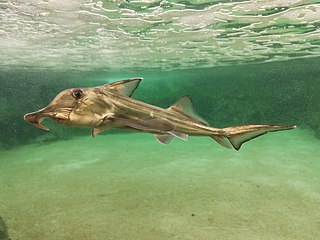
The Cape elephantfish, also known as josef or St Joseph shark, is a species of fish in the family Callorhinchidae.
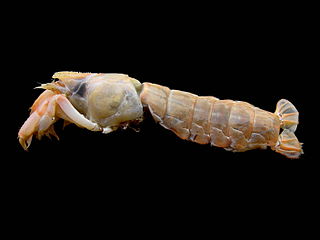
Upogebia deltaura is a species of mud lobster from the Atlantic Ocean and Mediterranean Sea.
Callianassa subterranea is a species of burrowing ghost shrimp. This species is known by such generic common names as "mud shrimp" and "ghost shrimp".

Sepia vermicularis, the patchwork cuttlefish.sometimes known as the common cuttlefish or ink-fish in South Africa, but the name common cuttlefish is more widely applied to Sepia officinalis. It is endemic to southern Africa.
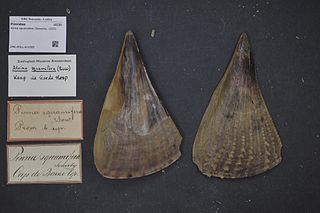
Atrina squamifera, one of several species known as the horse mussel, is a species of bivalve pen shell. It is a marine mollusc in the family Pinnidae. It is endemic to South Africa.
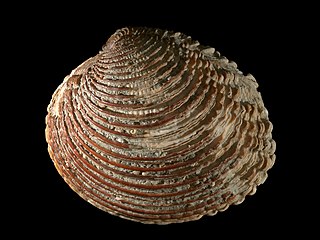
Venus verrucosa, the warty venus, is a species of saltwater clam. It is a species of marine bivalve mollusc in the family Veneridae, sometimes collectively known as the venus clams.

Nassarius capensis, common name the Cape dogwhelk, is a species of sea snail, a marine gastropod mollusk in the family Nassariidae, the Nassa mud snails or dog whelks.

Lepidophthalmus turneranus, the Cameroon ghost shrimp, is a species of "ghost shrimp" or "mud lobster" that lives off the coast of West Africa. It occasionally erupts into dense swarms, one of which resulted in the naming of the country Cameroon.

Genypterus capensis, commonly known as kingklip, is a species of cusk eel occurring along the Southern African coast from Walvis Bay in Namibia to Algoa Bay in South Africa. It is closely related to Genypterus blacodes from New Zealand. The species grows to a maximum length of 180 cm and a weight of 15.0 kg. It is one of the most popular fish items on South African menus. Despite appearances, it is not closely related to the eels of the order Anguilliformes.
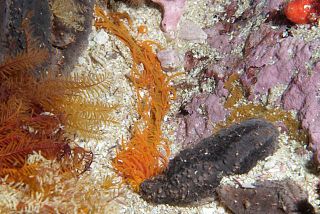
Cirriformia capensis, commonly known as the orange thread-gilled worm, is a species of marine polychaete worm in the family Cirratulidae.
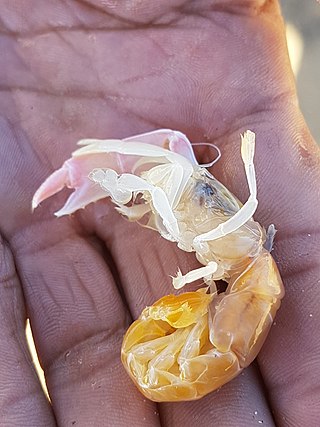
Kraussillichirus kraussi, commonly named the common sandprawn or pink prawn, is a species of ghost shrimp, an African crustacean in the family Callichiridae.

Anilocra capensis is a species of parasitic isopod in the family Cymothoidae. It is endemic to southern Africa. The species preferentially attaches itself to the hottentot seabream.

Pachymetopon blochii, the hottentot seabream or hottentot, is a species of sea bream in the family Sparidae, native to the southwestern coast of Africa.
Upogebia pugettensis, also known as the blue mud shrimp, is a species of mud lobster from the West Coast of North America.

Orthione griffenis, or Griffen's isopod, is an isopod parasite present in the waters off East Asia and the West Coast of North America.














